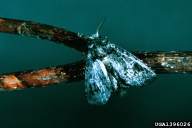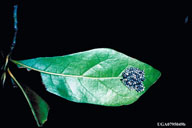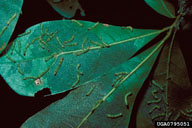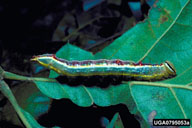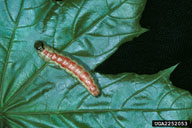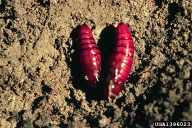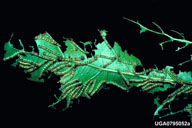Variable oak leaf caterpillar
Lochmaeus manteo (Doubleday) Lepidoptera: Notodontidae)
Orientation to pest
Variable oak leaf caterpillar, Lochmaeus manteo (Doubleday), is a native North American moth whose larvae feed on a wide variety of deciduous trees, especially oaks. The species is found across much of eastern North America. It overwinters as a prepupa in the soil and pupation occurs in early spring, with adult emergence following in May or June. Eggs are laid singly on the leaves of the host plant. The color pattern of larvae is variable. Young larvae skeletonize leaves, but older larvae eat entire leaves apart from the larger veins. There are two generations per year in the southern United States and one in the north. Outbreaks sometimes occur that defoliate large areas; however, tree mortality is usually very low.
Hosts commonly attacked
All species of oaks are attacked, but white oak (Quercus alba L.) is preferred. Other hosts include American beech (Fagus grandifolia Ehrh.), American basswood (Tilia americana L.), paper birch (Betula papyrifera Marshall), American elm (Ulmus americana L.), walnut (Juglans), boxelder (Acer negundo L.), persimmon (Diospyros sp.), and apple (Malus).
Distribution
The variable oak leaf caterpillar is found in a wide area in eastern North America, east of a line from western Ontario to eastern Texas.
Images of variable oak leaf caterpillar
| Figure 1. Adult of variable oak leaf caterpillar, Lochmaeus manteo | Figure 2. Eggs of variable oak leaf caterpillar | Figure 3. Young larvae of variable oak leaf caterpillar |
| Figure 4. Mature larvae of the variable oak leaf caterpillar (color patterns vary) | Figure 5. Pupae of variable oak leaf caterpillar | Figure 6. Feeding damage of variable oak leaf caterpillar | |
Important biological control agents related to this pest species
Among the nature enemies of this insect are egg parasitoids in the genera Trichogramma and Telenomus, which may kill 90% of the eggs. Nearly all egg masses have some parasitized eggs; only the eggs concealed within a cluster escape. This high level of parasitism and the failure of many prepupae to pupate in the spring, appear to be the major factors affecting population density. At least seven species of larval parasites attack variable oakleaf caterpillar larvae. The most important species are Diradops bethunei Cresson (Ichneumonidae), Protomicroplitus schizurae (Braconidae), and Lespesia schizurae Sabrosky (Tachinidae, which collectively may kill up to 90% of the larvae.
Web links for information on variable oak leaf caterpillar
- Fact Sheet from Maine Forest Service | State of Maine Department of Conservation
- Forest Insect & Disease Leaflet 67 | USDA Forest Service
Articles
- Surgeoner, G. A. and W. E. Wallner. 1978. Foliage consumption by the variable oak leaf caterpillar, Heterocampa manteo (Lepidoptera: Notodontidae), its use in defoliation predictions. The Canadian Entomologist 110: 241-244.
